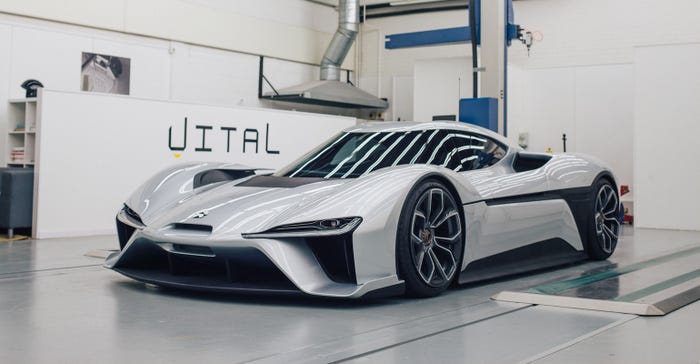Just How Did Vital Auto 3D Print Those Concept Cars?
In this Q&A we drill down into Vital Auto's fascinating 3D printing process for creating concept cars.

Vital Auto built the NIO EP9 concept EV using 3D printing in addition to traditional subtractive manufacturing techniques.Image courtesy of Formlabs
Our recent article on Vital Auto's use of 3D printing additive manufacturing to build exotic show cars for a variety of OEMs had us wondering about some of the details of this process.
Vital Auto and their 3D printer supplier, Formlabs, agreed to fill us in further with a Q&A that should provide still more information on this work.
Our interviewees were Adam Hourigan, Formalabs' technical sales engineer, and Shay Moradi, Vital Auto's vice president of innovation & experiential technology.
Design News: What exactly are the different materials that are used to print different parts of a concept car and what are the properties of each?
Adam Hourigan: The Vital Auto team used several materials from Formlabs’ vast material library to print a range of parts and to support design iteration, with both SLA and SLS materials. On the SLS side, the team used Nylon 12 Powder, a high performance nylon material ideal for functional prototyping and small batch production for its ability to withstand impact and absorb wear-and-tear over time to create production-quality parts, such as brake calipers and door handles. They also used SLA materials such as Draft Resin for its fast printing times to prototype a variety of parts, including air vents. Flexible 80A, one of Formlabs’ newer resins, was used for parts that would otherwise be expensive to manufacture, like door seals, to print sections overnight rather than over the course of several days, to test various geometries with extreme accuracy.
Design News: What kinds of 3D printers are better suited for which kinds of parts?
Adam Hourigan: Vital Auto used Formlabs’ SLA and SLS 3D printers, which each offer unique benefits to the design and production process. Using the Fuse 1 SLS printer saved two to four days in prototyping and testing, enabling the team to produce end-use parts for pieces like door hinges, door handle inners, door internals, and other structural components in less than 24 hours. The Form 3L, an SLA printer, enabled Vital Auto to produce auto parts with smooth finishes that could quickly be added to the vehicle as soon as they are printed.
Design News: How much time and cost are saved building concept cars this way rather than the old way?
Adam Hourigan: With 3D printing, Vital Auto was able to produce hundreds of parts with different geometries faster and more affordably than was ever possible before. The low cost per part enables Vital Auto to quickly create both prototype and end-use parts that bring new concepts to market more efficiently and more affordably.
Design News: Do these tools actually permit the concept cars to incorporate features that couldn’t be done the traditional way?
Compared to slow and costly traditional production methods like CNC milling, Formlabs printers have enabled Vital Auto to print more parts and deliver new design concepts faster and more affordably. With 3D printing, the Vital Auto team can embark on greater design exploration while speeding up time to production.
Design News: Which concept cars have been produced this way so far?
Shay Moradi: The Nio EP9, Apex AP 0, Tata H2X, Naran, and Royal Enfield KX100 concept, among others.
Design News: What component or detail was the hardest to create or was otherwise the item that you’re most proud of achieving?
Shay Moradi: We do make-believe without the make-believe. Understanding, imagining, and making sometimes puts you into the space of working on really complex projects or abstract things. For example, how can we use lighting to convey emotion? How can we humanize a machine? We use ambitious design investigations to explore these types of work. We wanted to bring emotion into a lighting program. Pininfarina Battista’s E-heart is a perfect example of interpreting and expanding on design intent with creative electronics. Breathing life into a piece of functional jewelry.
Design News: Are the resulting concept cars better/lighter/less fragile?
Shay Moradi: 3D printing allows us a greater opportunity to fill the timeline with more design iteration, things that are impossible to manufacture in condensed timelines with fewer resources are suddenly possible. It expands the creative appetite as much as the iteration space.
About the Author(s)
You May Also Like





